Salmon Creek, Humboldt County
Species / Location
The California Department of Fish and Wildlife (CDFW) collaborates with the Pacific States Marine Fisheries Commission to study juvenile salmonid use of the stream-estuary ecotone (SEE) of Humboldt Bay tributaries. This ecotone, which is defined as the confluence zone between streams and estuaries, has unique habitat characteristics. CDFW and Pacific Marine Fisheries Commission assess success of estuarine habitat restoration projects designed to create and improve juvenile salmon and steelhead (Figure 1A&B) rearing habitat in the SEE of Humboldt Bay and its tributaries.
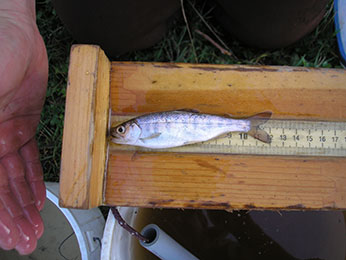 Figure 1A. Coho salmon species that are listed under the State and Federal Endangered Species Act, are monitored by CDFW in Salmon Creek estuary. (CDFW photo)
Figure 1A. Coho salmon species that are listed under the State and Federal Endangered Species Act, are monitored by CDFW in Salmon Creek estuary. (CDFW photo)
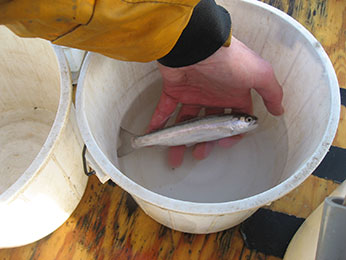 Figure 1B. Steelhead species that are listed under the State and Federal Endangered Species Act, are monitored by CDFW in Salmon Creek estuary. (CDFW photo)
Figure 1B. Steelhead species that are listed under the State and Federal Endangered Species Act, are monitored by CDFW in Salmon Creek estuary. (CDFW photo)
Although the study area includes the tidal portions of most Humboldt Bay tributaries, this case study focuses on the SEE of Salmon Creek, located on the U.S. Fish and Wildlife Service (USFWS) Humboldt Bay Refuge (Refuge) at the southern end of Humboldt Bay (Figure 2). Salmon Creek is habitat for state and federally-listed “Threatened” coho salmon, as well as for federally “Threatened” steelhead trout. There is also a substantial population of federally listed “Endangered” tidewater goby and a small number of state-listed “Threatened” longfin smelt (Figure 3 A&B).
 Figure 2. The major tributaries of Humboldt Bay. Salmon Creek (in purple) is located at the southern end of Humboldt Bay. (click/tap to enlarge)
Figure 2. The major tributaries of Humboldt Bay. Salmon Creek (in purple) is located at the southern end of Humboldt Bay. (click/tap to enlarge)
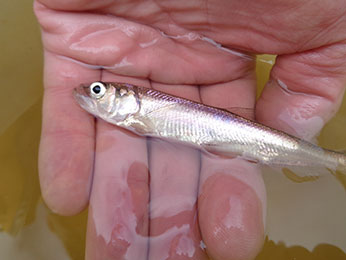 Figure 3A. In addition to coho salmon and steelhead, Salmon Creek estuary is important habitat longfin smelt. (CDFW photo)
Figure 3A. In addition to coho salmon and steelhead, Salmon Creek estuary is important habitat longfin smelt. (CDFW photo)
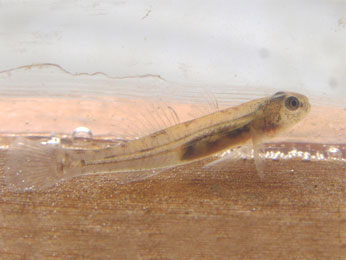 Figure 3B. In addition to coho salmon and steelhead, Salmon Creek estuary is important habitat tidewater goby. (CDFW photo)
Figure 3B. In addition to coho salmon and steelhead, Salmon Creek estuary is important habitat tidewater goby. (CDFW photo)
Beginning in 2011, the Refuge embarked on a large habitat restoration project in the Salmon Creek SEE, for which they installed new tide gates at the mouth of Salmon Creek to improve fish passage and to enhance habitat by increasing the tidal prism (the amount of water leaving the estuary between high and low tide). This project also included relocating and enlarging the Salmon Creek channel to handle the increased tidal prism as well as the construction of five off-channel ponds to provide rearing and transition habitat for juvenile salmonids during the winter and spring (Figure 4). CDFW’s role has been to assess the success of this restoration by monitoring water quality changes and fish response.
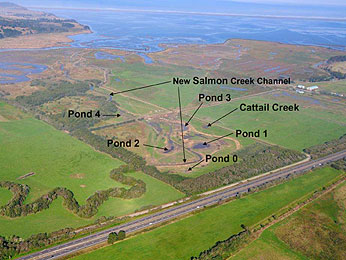 Figure 4. Fish and water quality sampling locations in the newly constructed off channel ponds, new Salmon Creek channel, old Salmon Creek channel, and Cattail Creek. (Photo: Dave Kenworthy)
Figure 4. Fish and water quality sampling locations in the newly constructed off channel ponds, new Salmon Creek channel, old Salmon Creek channel, and Cattail Creek. (Photo: Dave Kenworthy)
Need for Drought Stressor Monitoring
Until recently, very little was known about juvenile salmon (especially coho salmon) and steelhead trout use of the SEE and the necessary habitat conditions. Estuaries are important as a transition zone for fish to physiologically adapt to differences in salinity as they migrate between streams and ocean environments. CDFW has found that juvenile coho salmon and steelhead trout typically rear in the SEE for months (sometimes up to one year), and that they grow faster than their cohorts rearing in stream habitat. We have also found that juvenile salmonids spend the majority of their time in freshwater, including the freshwater habitat within the zone of tidal influence. There is a need to monitor biological response to restoration actions so that CDFW can more effectively plan future restoration actions to protect and restore fish populations. On top of this, during times of severe drought and reduced freshwater input into the estuary, there is a need to study how these extreme conditions have influenced habitat for native fishes.
Stressor Monitoring Efforts
CDFW conducts bi-weekly fish and water quality sampling in the SEE of Salmon Creek. We collect water temperature, salinity, and dissolved oxygen data throughout the water column in the main Salmon Creek channel and in the recently built off-channel ponds. We capture fish using seine nets and minnow traps baited with frozen salmon roe. We also operate a PIT (Passive Integrated Transponder) tag antenna station at the mouth of one pond to remotely detect tagged fish moving into and out of the pond (Figure 5 A&B). This helps us better understand fish usage of ponds over changing water quality conditions.
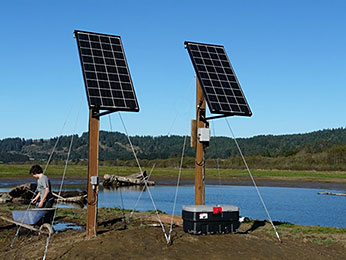 Figure 5A. PIT tag antenna station at the mouth of Pond 1 in Salmon Creek. This includes solar panels, power supply, and data loggers. (CDFW photo)
Figure 5A. PIT tag antenna station at the mouth of Pond 1 in Salmon Creek. This includes solar panels, power supply, and data loggers. (CDFW photo)
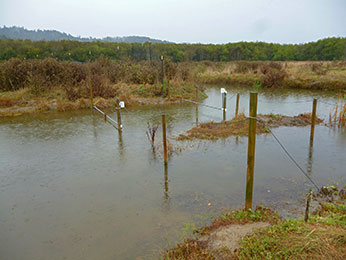 Figure 5B. PIT tag antennas and tag readers. (CDFW photo)
Figure 5B. PIT tag antennas and tag readers. (CDFW photo)
Findings
CDFW has found that drought effects of low stream flows entering the estuary have negatively impacted rearing conditions for salmon and steelhead trout by increasing the extent and duration of salt water influence, thus degrading water quality (increasing temperature and decreasing dissolved oxygen) conditions.
In average or above average rainfall years, increased stream flows flush saltwater from the SEE during the winter and spring increasing available freshwater habitat and improving conditions (lower temperature and higher dissolved oxygen concentrations) for juvenile salmonids. As flows begin to drop during the spring, brackish water begins to move upstream into the SEE. However, during years of normal rainfall and stream flow, instream flows produce an upper freshwater layer (on top of the saltwater layer), providing habitat for juvenile salmonids. Eventually, stream flows drop to low levels by late spring, resulting in brackish water conditions spreading throughout the SEE, reducing water quality conditions. Once these poor water quality conditions set-in, CDFW observes that rearing juvenile salmonids leave by June.
During the drought conditions of 2014, reduced rainfall and freshwater inflows produced conditions where salinity (and water temperature) was greater than it was in previous years and dissolved oxygen concentrations were lower. By April, the water column was salinity-stratified and by June, it became brackish throughout. By August, CDFW detected hyper-saline conditions (greater than that of sea water) throughout the water column of Salmon Creek due to lack of freshwater inflow and evaporation of saltwater, concentrating salinity. These were the highest salinity readings detected since monitoring began at this location in 2005.
In comparison, during a year (2012) of average rainfall, freshwater conditions persisted throughout the water column through May and an upper freshwater layer was present through June. Improved water quality conditions (lower temperature and higher dissolved oxygen levels) were observed.
Due to these drought conditions, it has made it more difficult for CDFW understand how the restoration work influences biological response during normal water years. During the recent drought conditions, CDFW has captured and detected substantially fewer juvenile coho salmon and steelhead trout in the Salmon Creek SEE compared to 2012 (Table 1).
Table 1. The number of juvenile coho salmon and steelhead trout captured in Pond 1 or detected at the PIT tag antenna station at the entrance to Pond 1, 2012-2014.
| Pond 1 |
2014 |
2013 |
2012 |
| Coho Captured |
10 |
3 |
90 |
| Coho Detected |
5 |
1 |
80 |
| Steelhead Captured |
22 |
1 |
11 |
| Steelhead Detected |
11 |
1 |
16 |
Future Efforts
CDFW will continue to study juvenile salmonid use of the SEE and assess the success of estuarine habitat restoration projects. Continuing to collect fish and water quality information during years that include average to above average rainfall will allow us to better understand the effects of restoration work on fish response beyond the effects of drought.
CDFW
Pacific States Marine Fisheries Commission
United States Fish and Wildlife Service’s Humboldt Bay Wildlife Refuge